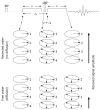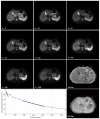Diffusion-weighted magnetic resonance imaging in cancer: Reported apparent diffusion coefficients, in-vitro and in-vivo reproducibility
- PMID: 26834942
- PMCID: PMC4731347
- DOI: 10.4329/wjr.v8.i1.21
Diffusion-weighted magnetic resonance imaging in cancer: Reported apparent diffusion coefficients, in-vitro and in-vivo reproducibility
Abstract
There is considerable disparity in the published apparent diffusion coefficient (ADC) values across different anatomies. Institutions are increasingly assessing repeatability and reproducibility of the derived ADC to determine its variation, which could potentially be used as an indicator in determining tumour aggressiveness or assessing tumour response. In this manuscript, a review of selected articles published to date in healthy extra-cranial body diffusion-weighted magnetic resonance imaging is presented, detailing reported ADC values and discussing their variation across different studies. In total 115 studies were selected including 28 for liver parenchyma, 15 for kidney (renal parenchyma), 14 for spleen, 13 for pancreatic body, 6 for gallbladder, 13 for prostate, 13 for uterus (endometrium, myometrium, cervix) and 13 for fibroglandular breast tissue. Median ADC values in selected studies were found to be 1.28 × 10(-3) mm(2)/s in liver, 1.94 × 10(-3) mm(2)/s in kidney, 1.60 × 10(-3) mm(2)/s in pancreatic body, 0.85 × 10(-3) mm(2)/s in spleen, 2.73 × 10(-3) mm(2)/s in gallbladder, 1.64 × 10(-3) mm(2)/s and 1.31 × 10(-3) mm(2)/s in prostate peripheral zone and central gland respectively (combined median value of 1.54×10(-3) mm(2)/s), 1.44 × 10(-3) mm(2)/s in endometrium, 1.53 × 10(-3) mm(2)/s in myometrium, 1.71 × 10(-3) mm(2)/s in cervix and 1.92 × 10(-3) mm(2)/s in breast. In addition, six phantom studies and thirteen in vivo studies were summarized to compare repeatability and reproducibility of the measured ADC. All selected phantom studies demonstrated lower intra-scanner and inter-scanner variation compared to in vivo studies. Based on the findings of this manuscript, it is recommended that protocols need to be optimised for the body part studied and that system-induced variability must be established using a standardized phantom in any clinical study. Reproducibility of the measured ADC must also be assessed in a volunteer population, as variations are far more significant in vivo compared with phantom studies.
Keywords: Apparent diffusion coefficient; Apparent diffusion coefficient reproducibility; Cancer imaging; Diffusion-weighted magnetic resonance imaging; Extra-cranial organs.
Figures



References
-
- Le Bihan D, Breton E, Lallemand D, Grenier P, Cabanis E, Laval-Jeantet M. MR imaging of intravoxel incoherent motions: application to diffusion and perfusion in neurologic disorders. Radiology. 1986;161:401–407. - PubMed
-
- Warach S, Chien D, Li W, Ronthal M, Edelman RR. Fast magnetic resonance diffusion-weighted imaging of acute human stroke. Neurology. 1992;42:1717–1723. - PubMed
-
- Le Bihan D. Intravoxel incoherent motion perfusion MR imaging: a wake-up call. Radiology. 2008;249:748–752. - PubMed
-
- Koh DM, Collins DJ. Diffusion-weighted MRI in the body: applications and challenges in oncology. AJR Am J Roentgenol. 2007;188:1622–1635. - PubMed
Publication types
LinkOut - more resources
Full Text Sources
Other Literature Sources

